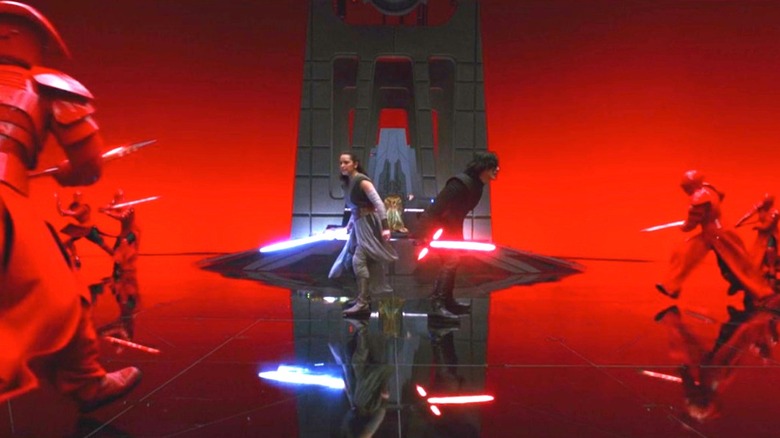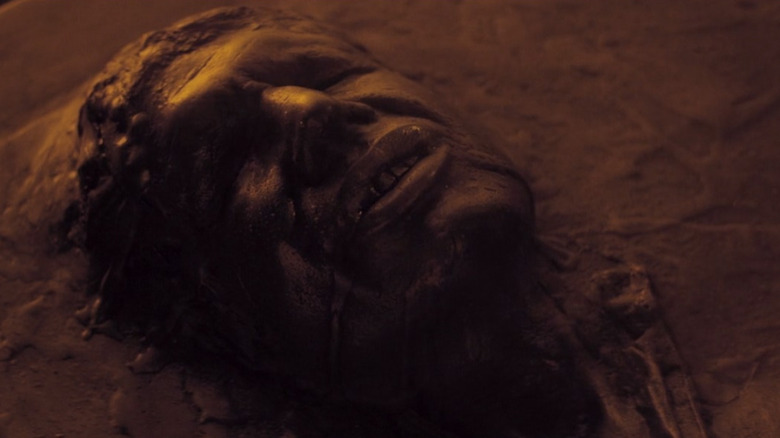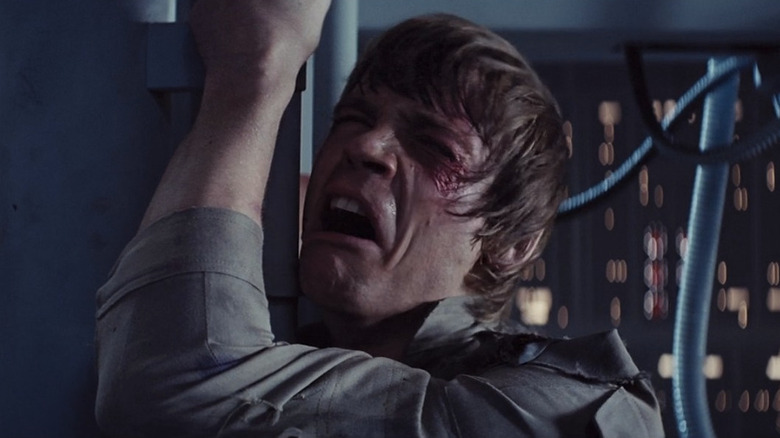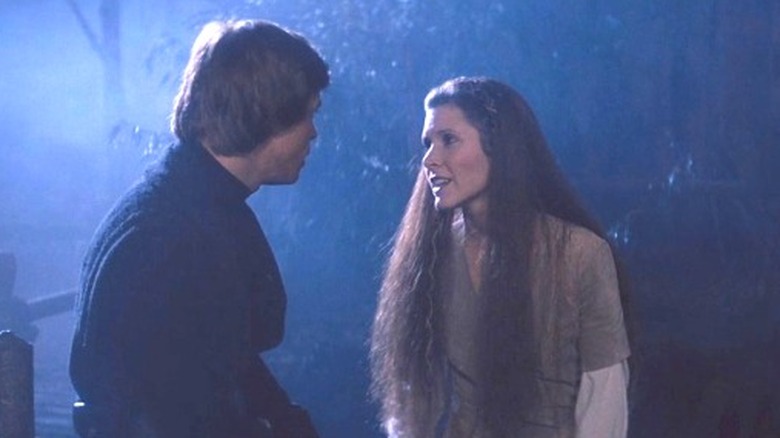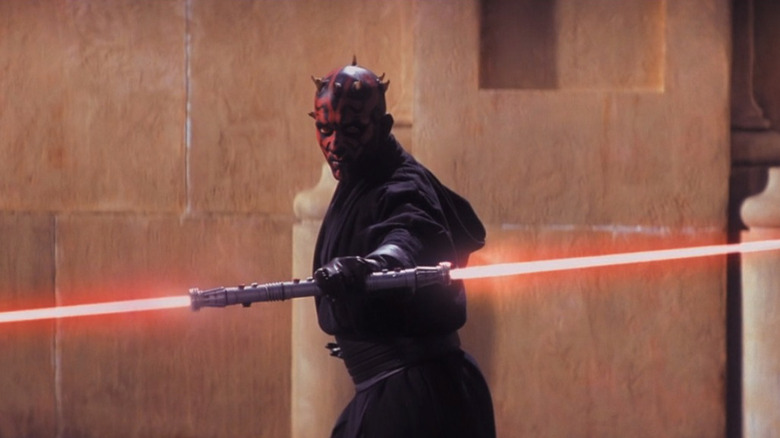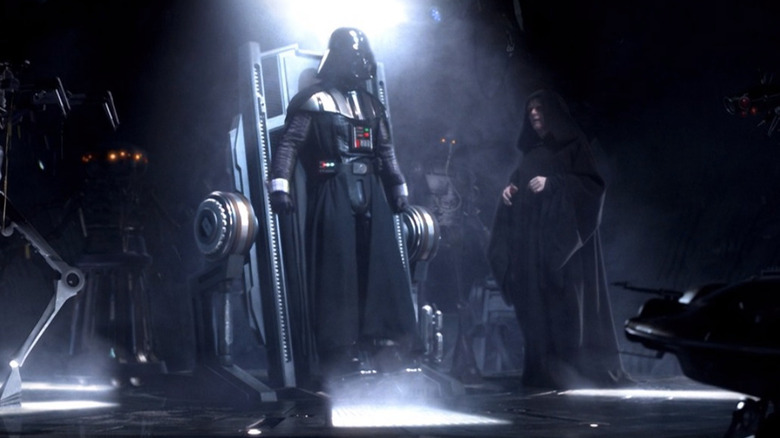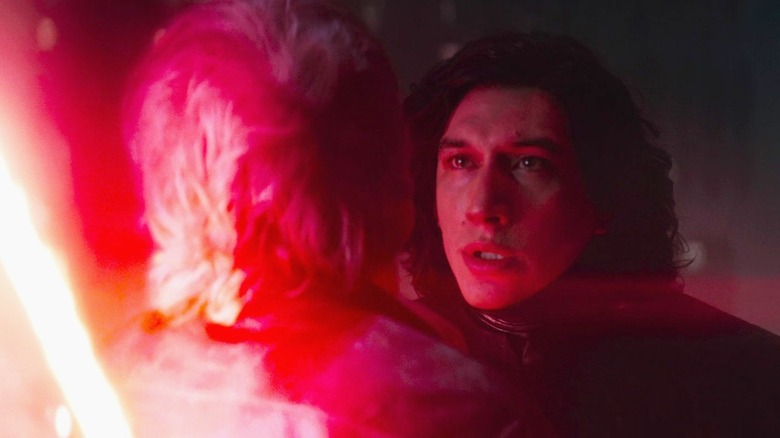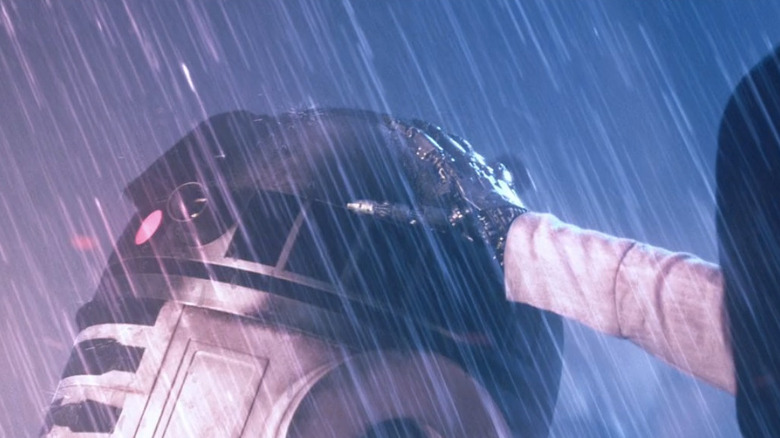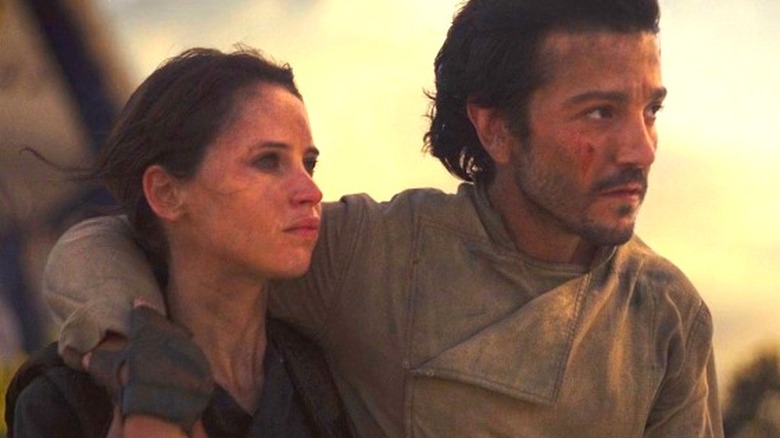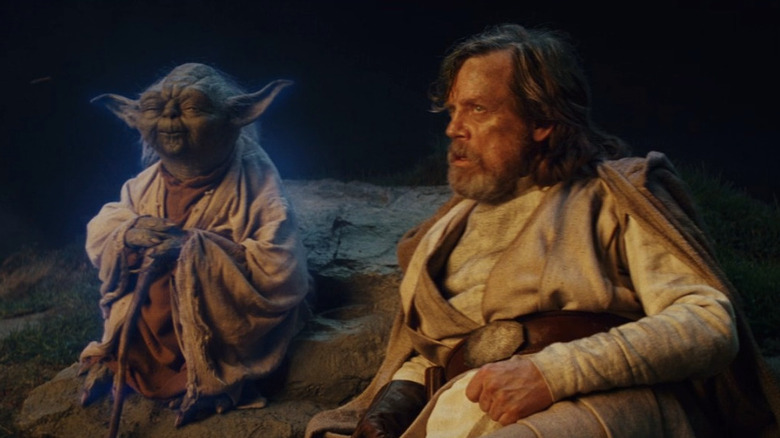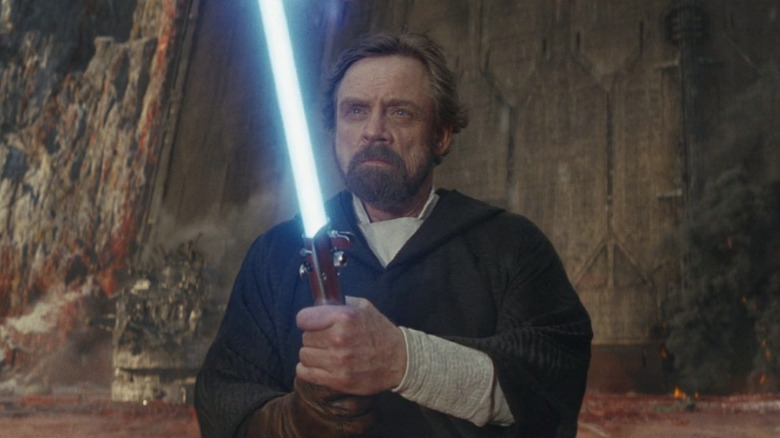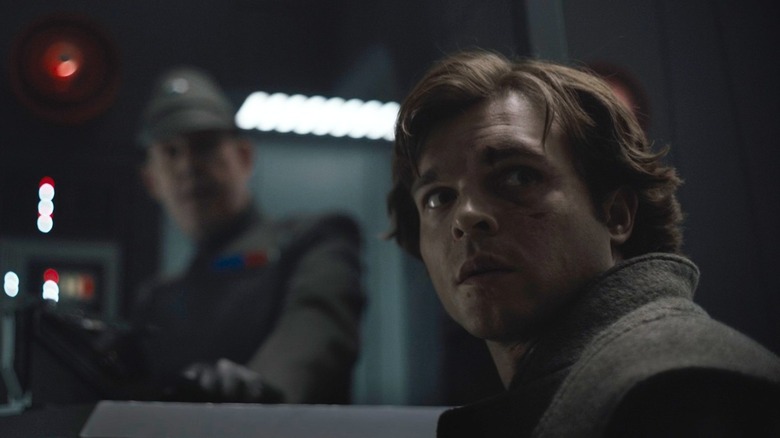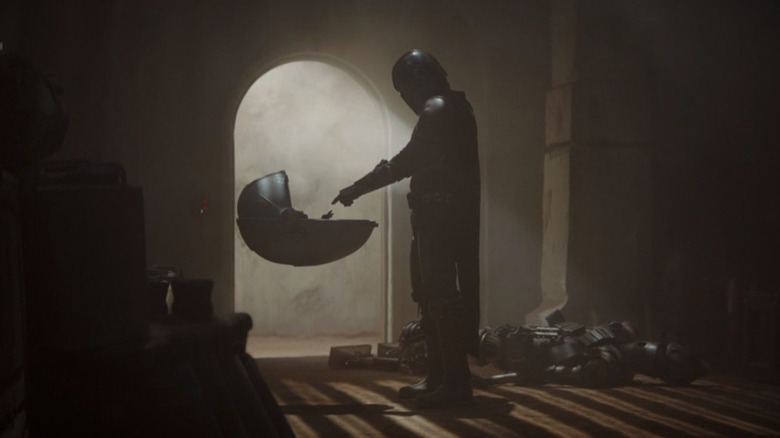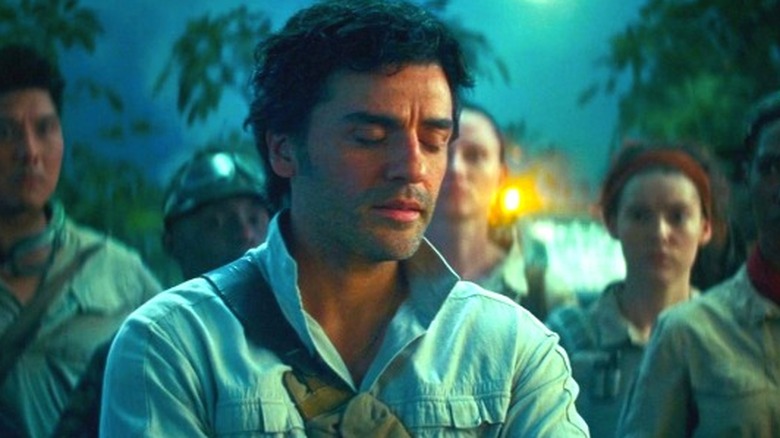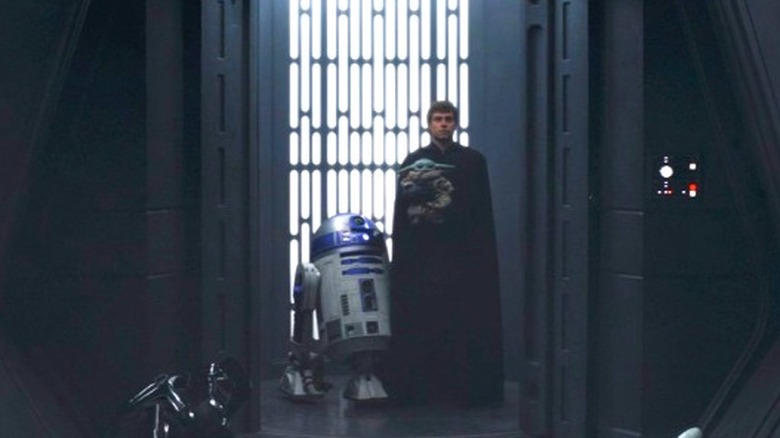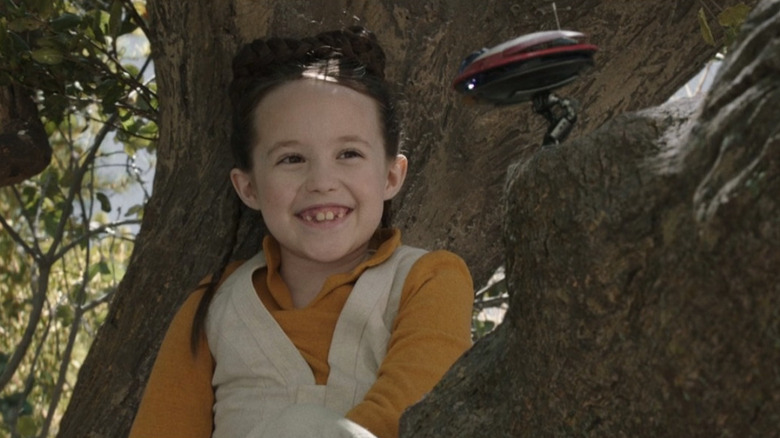Star Wars' Most Mind-Blowing Plot Twists
There's nothing like a good plot twist, and a long time ago in a galaxy far, far away, there were a lot of them. From revelations about the Skywalker family tree to gruesome deaths of heroes and villains alike, and everything in between, the "Star Wars" franchise has surprised audiences throughout its nearly five-decade history of films and television series.
Sometimes these bombshells have big payoffs — not only within "Star Wars" lore but in popular culture at large (who doesn't know about the famous "I am your father" twist?). Other surprises dovetail pretty quickly (we'll have plenty to say about deepfake Luke momentarily). For better or worse, "Star Wars" filmmakers like to keep viewers on their toes. These artists take big swings in terms of where they guide the narrative. Whether iconic or cringey, these unexpected turns are mind-blowing all the same.
Darth Vader freezes Han Solo in carbonite
The good guys always win, right? That may be the case for most stories — especially those of the family-friendly variety — but in 1980's "The Empire Strikes Back," storyman George Lucas concludes the second film in the original "Star Wars" trilogy on a tragic note.
Darth Vader (David Prowse/James Earl Jones) at last has a handful of our heroes, including Han Solo (Harrison Ford), in his clutches. The Sith Lord freezes the smuggler in carbonite, Han's pained face disturbingly imprinted in the shell. Some viewers might expect a swift resolution in time for the movie's end, but no such happy ending arrives. Audiences leave "The Empire Strikes Back" with Han Solo still frozen, his fate remaining in the balance until the next time.
In reality, Lucas didn't know what would happen next because Ford didn't know if he'd return for the third movie. Lucas opted for freezing Han as much out of necessity as narrative. If Ford came back, Han would unfreeze in the third installment. If Ford bowed out, Han's fate would be as sealed as the carbonite. Lucas' story was in the clear, no matter what happened behind the scenes.
Darth Vader is Luke's father
The cliffhanger to end all cliffhangers. In one of the final moments of "The Empire Strikes Back," Darth Vader — the epitome of everything Luke Skywalker (Mark Hamill) stands against — tells Luke, "I am your father." In an instant, Luke's world turns upside-down. Obi-Wan Kenobi (Alec Guinness) had told him Darth Vader killed his father, but the Jedi Master was merely being coy, turning a phrase to transform the truth.
The reveal of Vader's fatherhood is a keystone of popular culture, even among people who have never seen any "Star Wars" film. It's hard to imagine not knowing Vader is Luke's dad. For this very reason, audiences in 1980 were beside themselves with disbelief. The twist is practically common knowledge today, but at the time, it was a huge spoiler that Lucas and the team kept secret before the sequel's release.
Furthermore, it's impossible to overstate how influential Vader's daddy moment became to the narrative structure of pretty much any major franchise that followed. "Star Wars" was a first-of-its-kind Hollywood mega-series and naturally laid a blueprint that many artists attempted to emulate. Which big-budget film today doesn't end with a huge surprise, a final breadcrumb of mind-blowing information to keep you coming back for the next installment? Audiences in 1980 weren't as trained to expect that kind of structure as we are today. This means that not only was the twist itself a surprise, but even the presence of a twist was unexpected.
Luke and Leia are twins
"There is another," Yoda (Frank Oz) mystically declares. Yep, not only is Darth Vader Luke Skywalker's dad, but he's also the father of Leia Organa (Carrie Fisher), Princess of Alderaan. Luke and Leia are twins, unknowingly separated at birth for their own safety. In 1983's "Return of the Jedi," the original trilogy finale, they discover the truth.
Leia tells Luke, "Somehow, I've always known." Unsettling romantic undertones aside (see: Luke and Leia's kiss in the previous installment), separating this news from Vader's bombshell in "The Empire Strikes Back" lets the audience soak in each revelation as its own piece of information. Even though it would be quite the double-whammy to discover Darth Vader is Luke and Leia's father at the same time, giving these plot twists some space allows us to consider the dynamic of Luke's relationship with each respective character separately. Leia is Luke's twin, and she's also Force-sensitive. Luke doesn't just gain a sibling; he gains a fellow Jedi.
Darth Maul's double lightsaber
What's the only thing cooler than a lightsaber? How about a double-sided lightsaber? In 1999's "Star Wars: Episode I — The Phantom Menace," the first entry in the prequel trilogy, Darth Maul (Ray Park/Peter Serafinowicz) wields a lightsaber that emanates with a red glow from two ends. Thus, one of movie history's most legendary props instantly got even more iconic.
As Darth Maul engages in combat with Qui-Gon Jinn (Liam Neeson) and Obi-Wan Kenobi (Ewan McGregor), composer John Williams understands the assignment. Williams pads their battle sequence with "Duel of the Fates," an operatic theme created specifically for "The Phantom Menace." The track sounds, well, menacing, while also upbeat — two qualities that don't typically pair together. Always a masterful creative, Williams expertly shows restraint in not overdoing it. During the duel's most intense moments, he lets the lightsabers' diegetic sound effects speak for themselves, which helps make "Duel of the Fates" shine all the more when Williams activates its power again.
Even against two Jedi, Darth Maul is more than a formidable opponent, eventually killing Qui-Gon before falling to his presumed death (which he actually survives). All of these qualities culminate for a sequence that isn't just mind-blowing because of its coolness factor (though it has plenty of that) but because of how that coolness factor influences the narrative.
Anakin Skywalker becomes Darth Vader
Okay, so the majority of the audience watching 2005's "Revenge of the Sith" knows where the story is headed, even if they're watching for the first time. This is the movie when Anakin Skywalker (Hayden Christensen) turns to the dark side to become Darth Vader, arguably the quintessential villain in film history. Everybody knows that ... right? Not quite.
In the binge-watch era of enjoying years or sometimes decades of movies or television series in large quantities, modern audiences new to "Star Wars" have a choice. For simplicity's sake — for the sheer notion of story comprehension in such a brief amount of time — some binge-watchers may prefer to view the series in the "timeline order" of the story rather than the "release order" of the movies. George Lucas himself even suggests watching in timeline order.
If a viewer takes this approach and goes in blind, some story points conceived as retroactive backstory are posited as major plot twists. The greatest of which, arguably, is Anakin becoming Vader. "All right," you might be thinking, "that logic makes sense, but there's no way someone doesn't know about Vader's history, even peripherally." That's what I thought too — until I met someone who fell for the whole thing, hook, line, and sinker. She was gobsmacked when she watched "Revenge of the Sith" and realized this character she was invested in since his youth grows up to be the Sith Lord.
Kylo Ren kills Han Solo
"I know what I have to do, but I don't know if I have the strength to do it." In 2015's "The Force Awakens," Kylo Ren (Adam Driver) — otherwise known as Ben Solo, son of Han and Leia — is a rising star in the First Order, a new(ish) faction of the dark side. Kylo finds inspiration from his grandfather, Darth Vader, rather than his heroic parents.
When director J.J. Abrams establishes a wide shot inside a huge hangar within Starkiller Base, some audience members might perceive the writing on the wall. Han Solo approaches his son on a narrow walkway in the middle of an otherwise empty black void, with no railings on the walkway and nothing but a dark abyss below it. Rey (Daisy Ridley), Finn (John Boyega), and Chewbacca (Peter Mayhew/Joonas Suotamo) watch from platforms above, the walkway inaccessible to them.
Composer John Williams opts for no music in lieu of diegetic sound effects of the wind, giving the moment even more drama. We might not know exactly what's about to happen, but the staging and sound choices make us anticipate something tense and maybe even tragic. Sure enough, after Han delivers a heartfelt plea for his son to come home, Kylo wedges his flame-sizzling lightsaber into his father's chest. Williams chooses this moment to re-introduce the score, with Han lovingly reaching for his son's face before falling into the abyss to his death.
Wait, is Luke even in this movie?
Disney and Lucasfilm touted "The Force Awakens" as the grand return of Mark Hamill, Carrie Fisher, and Harrison Ford to the "Star Wars" galaxy. There was no reason to believe the three of them weren't the film's leads — or at least, held important roles — alongside the new, younger characters.
As the release date neared, Hamill was absent from the film's poster and trailers (save for a quick shot of his robotic arm touching R2-D2). Meanwhile, Fisher and Ford appeared in nearly every promo. It was suspicious, but Hamill's name was still smack dab among the main cast in the credits at the bottom of the poster, even if his face wasn't in the artwork.
While watching "The Force Awakens" for the first time, viewers might wonder if Luke is even in the movie at all. Rather than pretend like Hamill wasn't in the film — and attempt with no avail to conceal a huge spoiler, a la "Spider-Man: No Way Home" — the marketing team sneakily averted expectations by employing the opposite tactic for the marketing campaign. Hamill was openly involved with the film, but the capacity was never once questioned, and that's what made the technique so effective in maintaining some level of surprise. Luke finally does appear in the film, but only in its last moments, as Rey approaches him on the remote planet of Ach-To and extends his old lightsaber to him.
The Rogue One crew dying
As a prequel, 2016's "Rogue One: A Star Wars Story" has to work extra hard to take the narrative to unexpected places because the audience already knows how it ends, to some degree. Even though we might know this is the story of how the good guys retrieved the Death Star plans, we might not realize the sacrifice involved until things turn grim in the film's finale.
"Rogue One" concludes with main characters Chirrut Îmwe (Donnie Yen), K-2SO (Alan Tudyk), Bodhi Rook (Riz Ahmed), Baze Malbus (Jiang Wen), Cassian Andor (Diego Luna), and Jyn Erso (Felicity Jones) all perishing in their fight to bring down the Empire's tyranny. Though they ultimately complete their mission, doing so costs them their lives.
You'd be forgiven for watching "Rogue One" and simply assuming that Jyn, Cassian, and their peers will part ways with the Rebel Alliance or otherwise go off-grid at the film's end. After all, none of them appear in the next story in the timeline, which happens to be the original "Star Wars." Alas, this is not to be. Their deaths provide "A New Hope" with more context and an extra sense of weight. The succeeding events of the original trilogy, along with the heroes that become entangled in the story, all fall into motion because of the "Rogue One" crew.
Let the past die
In 2017's "The Last Jedi," writer-slash-director Rian Johnson disillusions many of the qualities previous "Star Wars" films bestowed gravitas upon. Picking up immediately where "The Force Awakens" concluded, "The Last Jedi" shows Luke accepting his lightsaber from Rey, only to toss it over his shoulder haphazardly like it's a piece of trash. Later, Yoda's Force ghost appears to burn the only known copies of the ancient Jedi texts. The symbolism is anything but subtle (and anything but unanimously accepted by fans), but Johnson is deliberate in his message's differentness: moving forward sometimes means starting new rather than clinging to the old.
That's an unfamiliar concept for a franchise that endlessly emphasizes the importance of upholding the traditional Jedi religion, and one that comes as a bit of a jolt. Whether this jolt is positive or negative depends on who you ask. As Kylo Ren says in this installment, "Let the past die. Kill it if you have to. That's the only way you can become who you were meant to be." Perhaps the most valiant example of this mantra — and arguably one of the most impressive sequences in the entire sequel trilogy — is the infamous "red throne room scene," in which Kylo and Rey take down Supreme Leader Snoke (Andy Serkis), a mind-blowing moment if there ever was one.
Luke isn't really on Crait
During the climax of "Star Wars: The Last Jedi," the Resistance flees the First Order on Crait. Just when it seems as if Kylo Ren and company have the heroes cornered, Luke Skywalker steps in to defend his friends. It's the first time he's joined the Resistance's fight in recent memory — and Kylo relishes the opportunity to destroy his uncle. There's just one thing: every attempt to kill Luke returns void. That's because Luke's not really on Crait. He's still on Ach-To, remotely projecting his likeness across the galaxy using the Force.
The reveal here is pretty dope. Writer-slash-director Rian Johnson could have let the audience in on Luke's trickery from the beginning, leaving only Kylo Ren in the dark about Luke's actual whereabouts. However, by giving us only as much information as Kylo has, Johnson cleverly creates a moment of surprise when Kylo ultimately realizes what's happening at the same time we do.
Han becomes Solo
Prequels, spinoffs, and other extended universe material tangential to the primary projects of any given franchise provide filmmakers with an opportunity to dig deeper into the lore of their fictional subject. Sometimes, further exploration of a story's mythology provides a richer understanding and appreciation for what came before. Other times, the audience might wonder why every erroneous detail requires an origin story.
The latter is the case in 2018's "Solo: A Star Wars Story," the one-off movie starring Alden Ehrenreich as a young(ish) Han Solo and taking place shortly before the events of the original "Star Wars." In their script, writers Jonathan Kasdan and Lawrence Kasdan answer a question that not many audience members probably asked: "How did Han Solo get his name?" As it turns out, the only reason Han is named Solo is because he happened to be traveling "solo," and an attendant haphazardly issued him a new last name. Mind kinda blown, but in a face-palm sorta way.
Granted, if any writers have the license to make this kind of decision, it's these guys. Particularly, Lawrence Kasdan has some serious authority, having previously co-written "The Empire Strikes Back," "Return of the Jedi," and "The Force Awakens," among other films, and being the sole screenwriter of "Raiders of the Lost Ark." If Kasdan says Han Solo got his name because he was traveling solo, I'm inclined to respect that decision.
Din Djarin meets The Child
For as huge of a phenomenon as Baby Yoda became in the wake of "The Mandalorian" debuting with the launch of Disney+ in 2019, it's easy to forget the filmmakers kept the character a secret until the show premiered. As tempting as it would have been to plaster Grogu all over the show's advertising, Disney and Lucasfilm instead focused on Din Djarin (Pedro Pascal) and his action-packed adventures. It wasn't until the very last scene in that first episode that the audience first saw Grogu.
With "The Mandalorian" being the first-ever live-action "Star Wars" television series, creator Jon Favreau had his work cut out for him crafting a story that would compel and surprise longtime fans and newcomers alike. Baby Yoda, as the character came to be affectionately named within the zeitgeist of popular culture, was the perfect entryway into that precarious space.
The adorable, comical character brought to life primarily by puppeteers is at once important to the lineage of the "Star Wars" cast because of his relation to Yoda's species, and yet also completely endearing to someone who has never seen — as Lucille Bluth would say — "a Star War." Grogu also leaped to stardom beyond the show, becoming a favorite subject of memes and even receiving a balloon created in his likeness for the Macy's Thanksgiving Day Parade.
Somehow, Palpatine returned
Disney and Lucasfilm surprised fans by prominently showing Emperor Palpatine (Ian McDiarmid) on a teaser poster for 2019's "Star Wars: The Rise of Skywalker," the final entry in the sequel trilogy. The previous two films showed zero indication that Palpatine was in any way still alive, leading his sudden reappearance — and everything this sets into motion — to seem out of left field and not explained very well within the story.
As Poe Dameron (Oscar Isaac) tells the Resistance, "Somehow, Palpatine returned," many audience members can't help but notice the blatant vagueness of screenwriters Chris Terrio and J.J. Abrams — as if they don't even really know. Palpatine implies to Kylo Ren that he's been pulling the strings of the First Order all along, but the twist still feels weak.
Abrams returned to helm "The Rise of Skywalker" after its previously hired director, Colin Trevorrow, left the project. Rather than continuing the trains of thought established by Rian Johnson in "The Last Jedi," Abrams erases those story beats with contradictory information. No matter which director you prefer, the back-and-forth demands a lot from the audience, and it becomes exhausting. One of the greatest offenders of this philosophy is the revisionist history of Rey's family. Whereas Johnson told us Rey was a "nobody," Abrams swerves to instead reveal she's the granddaughter of Emperor Palpatine, who, alas, has "somehow returned."
Luke retrieves Grogu
Love it or hate it, no one saw it coming. In 2020's "The Mandalorian" Season 2 finale, Din and Grogu come face to face with Luke and R2-D2, who have come to retrieve Grogu and raise him among other in-training Jedi. "The Mandalorian" takes place a few years after "Return of the Jedi"; as such, Luke looks visually similar to his "Return of the Jedi" appearance, courtesy of (or rather, the fault of) de-aging technology to make Hamill appear nearly 40 years younger.
As Din emotionally says goodbye to Grogu — even breaking his Mandalorian vow by removing his helmet so Grogu can see his face — their parting of ways feels permanent. Composer Ludwig Göransson knocks it out of the park with an outstanding soundtrack that heightens the tinge of finality in this sequence. If creator Jon Favreau and his team had wanted to, this moment could have acted as a series finale, Mando's mission complete and Grogu's training with Luke left to our imaginations.
Instead, things swerve real fast when deepfake Luke returns in "The Book of Boba Fett." Luke tells Grogu he can go back to Din if he wants, which he does. By the start of "The Mandalorian" Season 3, Din and Grogu are back in action as if their farewell never happened, leaving viewers who didn't watch "Boba Fett" thoroughly confused.
This is Leia's story
If there's one thing modern "Star Wars" productions are gonna do, it's be coy about the prominence of Luke Skywalker in any given story. In the 2022 limited series "Obi-Wan Kenobi," Ewan McGregor returns as the titular character for an adventure set roughly a decade after "Revenge of the Sith."
Marketing showed Obi-Wan on Tatooine, looking after a young Luke Skywalker from afar. There seemed to be some indication that Luke might play an important role in the narrative. Instead, the filmmakers flip expectations. Yes, 10-year-old Luke (Grant Feely) appears in the series, but only anecdotally. The story focuses on Obi-Wan protecting young Leia (Vivien Lyra Blair). Like Grogu's debut in the first episode of "The Mandalorian," the marketing team omitted Leia from any promotional materials and left her appearance a surprise revealed in the "Obi-Wan Kenobi" premiere. As the story continues, the audience realizes Leia isn't just a bit cameo. It doesn't take long to figure out the clever misdirect: this is Leia's story, not Luke's.
